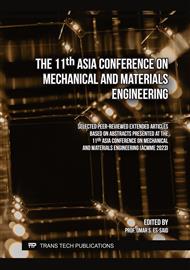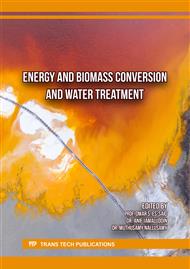[1]
E.E. Kuznetsova, A.A. Mishchenko, N.P. Korotkova, V.V. Safonov, Use of Polyurethane Dispersions In Pigment Printing of Textile Materials Based on Natural and Chemical Fibre Blends, Fibre Chemistry, 46 (2015) 384-387.
DOI: 10.1007/s10692-015-9626-9
Google Scholar
[2]
Y. Zhang, Y. Zhu, S. Zheng, L. Zhang, X. Shi, J. He, X. Chou, Z.-S. Wu, Ink formulation, scalable applications and challenging perspectives of screen printing for emerging printed microelectronics, Journal of Energy Chemistry, 63 (2021) 498-513.
DOI: 10.1016/j.jechem.2021.08.011
Google Scholar
[3]
N.A. Ibrahim, H.M. Fahmy, M. Awad, L.E. El Badawy, Influence of Selective Chemical Pretreatments on Eco-Friendly Pigment Printing of Polyester/Cellulosic Blends, Polymer-Plastics Technology and Engineering, 44 (2007) 133-150.
DOI: 10.1081/pte-200046105
Google Scholar
[4]
M.Z. Li, H. Yin, Y. Cheng, The Printing Technology of New Pigment Used on Cashmere Products, Advanced Materials Research, 331 (2011) 225-228.
DOI: 10.4028/www.scientific.net/amr.331.225
Google Scholar
[5]
L. Zhang, Q. Zhou, Q. Zhang, M. Wu, New Washing-Free Printing Binder Based on Fluorosilicone-Modified Polyacrylate for Polyester Fabric Printing with a Disperse Dye, Fibers and Polymers, 22 (2021) 396-404.
DOI: 10.1007/s12221-021-9090-5
Google Scholar
[6]
V. Jalan, B.S. Butola, Influence of Binder Type on Color Characteristics of Cotton Fabric Colored with a Photochromic Colorant, Journal of Natural Fibers, 15 (2017) 229-238.
DOI: 10.1080/15440478.2017.1325425
Google Scholar
[7]
N.A. Ibrahim, M.R. El-Zairy, S. Zaky, H.A. Borham, Environmentally Sound Pigment Printing Using Synthetic Thickening Agents, Polymer-Plastics Technology and Engineering, 44 (2007) 111-132.
DOI: 10.1081/pte-200046103
Google Scholar
[8]
Y. Yang, M. Li, S. Fu, Use of highly-stable and covalently bonded polymer colorant on binder-free pigment printing of citric acid treated cotton fabric, Cellulose, 28 (2021) 1843-1856.
DOI: 10.1007/s10570-020-03644-2
Google Scholar
[9]
S. Tepparin, P. Sae-be, J. Suerat, and S. Chumrum. Preparation of Tamarind-seed thickener for pigment printing on cotton. Advanced Materials Research Vols. 233-235 (2011) pp.1388-1391
DOI: 10.4028/www.scientific.net/amr.233-235.1388
Google Scholar
[10]
X. Jiang, H. Hu, Y. Bai, X. Tian, D. Huang, S. Wang, Synthesis and properties of the vinyl silicone oil modified polyacrylate core-shell latex as a binder for pigment printing, Journal of Adhesion Science and Technology, 27 (2013) 154-164.
DOI: 10.1080/01694243.2012.701527
Google Scholar
[11]
X. Jiang, J. Gu, X. Tian, D. Huang, Y. Yang, Synthesis of the Hydroxyl-Containing Poly(dimethyl siloxane) Modified Polyacrylate Core-Shell Latex and the Application as a Novel Binder for Pigment Printing of Fabric, Journal of Dispersion Science and Technology, 32 (2011) 1266-1272.
DOI: 10.1080/01932691.2010.505790
Google Scholar
[12]
S.M.M. Kabir, S.D. Kim, J. Koh, Application of Jackfruit Latex Gum as an Eco-friendly Binder to Pigment Printing, Fibers and Polymers, 19 (2018) 2365-2371.
DOI: 10.1007/s12221-018-8060-z
Google Scholar
[13]
P. Venkatachalam, R. Jayashree, K. Rekha, S. Sushmakumari, S. Sobha, P. Kumari Jayasree, R. Gopikkuttanunithan Kala, A. Thulaseedharan, Rubber Tree (Hevea brasiliensis Muell. Arg), Agrobacterium Protocols, 2, 153-164
DOI: 10.1385/1-59745-131-2:153
Google Scholar
[14]
C. Sowcharoensuk, Industry Outlook 2022-2024: Natural Rubber, Krungsri Research, 2022, 1-25.
Google Scholar
[15]
N. saetung, Natural Rubber: Application as Starting Materials to Replace, Burapha Science Journal, 19 (2014) 199-209.
Google Scholar
[16]
K. Gomes, E. Guenther, J. Morris, J. Miggelbrink, S. Caucci, Resource nexus oriented decision making along the textile value chain: The case of wastewater management, Current Research in Environmental Sustainability, 4 (2022).
DOI: 10.1016/j.crsust.2022.100153
Google Scholar
[17]
I. Khan, B.T. Poh, Natural Rubber-Based Pressure-Sensitive Adhesives: A Review, Journal of Polymers and the Environment, 19 (2011) 793-811.
DOI: 10.1007/s10924-011-0299-z
Google Scholar
[18]
A.A. El-Wakil, Enhancement of Adhesion between EPDM and Polyester Fabric by Using Natural Rubber Modified by Maleic Anhydride, International Journal of Polymer Science, 2011 (2011) 1-4.
DOI: 10.1155/2011/591948
Google Scholar
[19]
Printing, 2023 16 January 2023 [cited 2018; Available from https://tanatexchemicals.com/
Google Scholar



